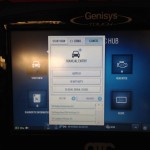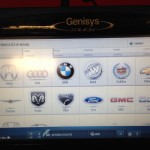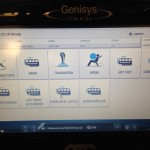Being a fairly well-balanced scan tool at a reasonable price, the Genisys Touch has been my primary tool for computer diagnostics. It has a decent amount of support for various modules on domestic, Asian, and European vehicles. The wireless and J2534 aspects of the tool are also very nice to have.
The Genisys Touch is a two-part tool consisting of a tablet computer and a wireless vehicle communications interface (VCI). An AC charger, USB cable, and various vehicle interface cables are included. The main part of the tool, the tablet, has a 10-inch touchscreen, power and function buttons, VGA output, SD card slot, Ethernet slot, power jack, and 2 USB ports. The VCI communicates to the tablet over Bluetooth, and has a serial connection for the OBD interface cable, USB port, and power jack.
The tool comes up fairly quickly to the home screen, where you can select Start New to input vehicle information, go the web browser, or launch the oscilloscope (if you have the scope attachment). In the vehicle selection process you can use Auto-ID on a fairly broad range of vehicles, or proceed with Year/Make/Model selection, then select the controller you wish to access, of which there is usually a robust selection.
Once a vehicle and controller is selected there are various maintenance tests, DTC functions, special tests, and data stream options. The maintenance and special tests are fairly good about what they cover, though it can be unclear if what you want should be considered “maintenance” or “special,” so there is some trial and error there. This is also where the tool seems to lack some of the basic bi-directional tests. I do not believe I have come across the first vehicle that I could control the coolant fans with this tool, though it does offer many more advanced controls that I wouldn’t expect at times.
DTC functions offers the usual options to read and clear codes, as well as to do a full system scan for DTC’s across all controllers, which can be rather nice. The DTC results of either option can be printed over wireless or e-mailed the same way if you have your printer set up as e-mail. I got into a habit of e-mailing my DTC’s each time I pulled them so I could always access them at my computer instead of having to write them down, remember them, or re-pull them. The ability to recall DTC’s later from your e-mail is good too in case a vehicle comes back and you want to know if it has all the same DTC’s or not. You may have some trouble with DTC’s on less common vehicles, such as the 1994 Mercedes S500 that I had come in showing every DTC being set that could be, when only a coolant temperature sensor DTC was set according to my Solus Ultra. The tool was also unable to clear DTC’s on this vehicle.
The data stream options are nice and what you would probably expect. You can select certain PID’s to view, whether a PID is displayed numeric only, with a horizontal meter, or with a graph. PID’s can also be sorted by graph vs numeric, by the ones you have selected vs non-selected, or alphabetically. PID’s can also be recorded and reviewed through a recording toolbar at the bottom of the screen. One draw-back to the data stream is when a PID is displayed in a different unit than expected (Fahrenheit vs Celsius, for instance) or displayed incorrectly in general, such as a 2007 Dodge Ram that constantly showed on this tool as being around 400+ degrees, while showing correctly on other tools. My largest complaint of live data on this tool, however, is that if you scroll through PID’s, buffers are reset on all the PID’s, meaning that unless you’re recording, only the PID’s on the display show their history, so if you want to scroll up to see what that long-term fuel trim just did when it wasn’t in the viewing area on the screen, tough luck.
The Genisys Touch also has support for Global OBD2 along with Mode 6 data. The Mode 6 data display of the tool I find to be more useful than the one on my Solus Ultra. When I go into Mode 6 on a ford looking for a missing cylinder, each parameter is shown in sequence, just like on a regular data stream display, whereas the Solus requires you to select the parameter, then it pulls the value for that one only, then you go back and select the next ones, which means that going through all 8 cylinder misfire parameters on a 5.4 takes much longer than on the Genisys.
The other part of the tool, the VCI, is notable for the fact that it also serves as a J2534 programmer. A software CD comes with the tool to allow you to connect it via USB cable to a shop computer with internet access, from which you can perform reprogramming tasks on pretty much any vehicle ECU, though you will require a subscription to the OEM service programming website.
Pros
- J2534 programming capability
- Domestic, Asian, and European coverage
- DLC adapters for all makes coverage
- Large screen
- Data recording, graphing, playback
- E-mail or print DTC and other reports
Cons
- Incomplete bi-directional control support
- Buggy PID’s
- Spotty coverage for less common vehicles
Website: OTC Tools
Cost: $3499.00
Below are PDF attachments to see what the output of various DTC functions are on different vehicles.
1994_Mercedes-Benz_S500_(140) – Incorrect DTC display 2004_BMW_745Li_(E66) – Engine DTC’s
150_XL_4.6 – F150 Automated System Test
2006_Volvo_XC90 – Engine DTC’s






